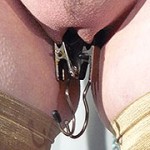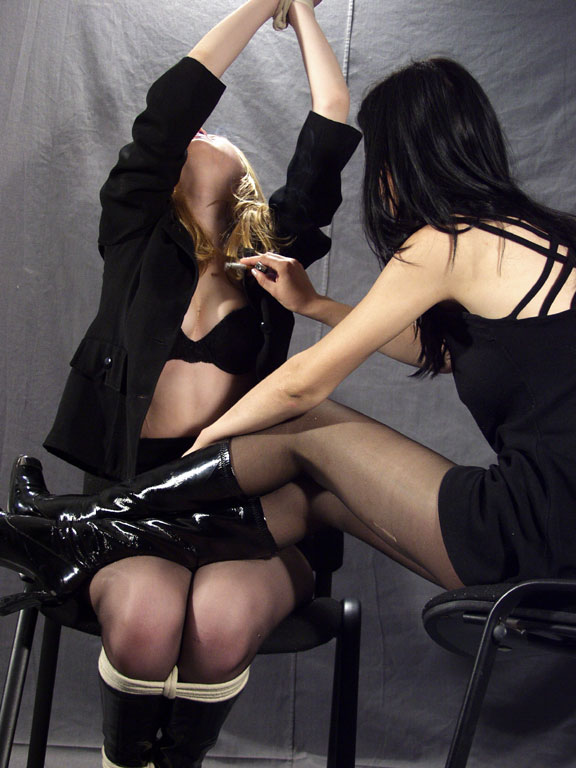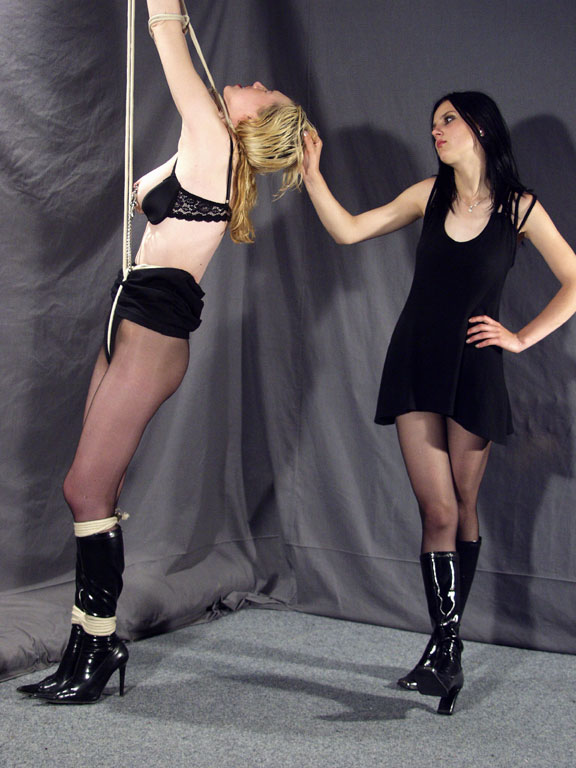Bondage
Bondage (from the English verb to bind, link) is an erotic practice of force, one way or another, his / her partner. The bondage of forcing the body in its entirety or in part, usually with ropes and gags, but also to tape, straps, chains, or any other utensil adapted to exert a grip on or part (s) of the body concerned (s). The motion of the partner is not necessarily the goal. Thus speak bondage arms, legs, chest / breast, size, and so on.
This particular form of sexuality is often mistakenly equated with sadomasochism, while these are two distinct practices. The fundamental difference is that in pure bondage, coercion is a goal in itself, often aesthetic (but not only), while in sadomasochism this is a simple, one tool among many other. Moreover, in the pure bondage, we do not find the concepts of dominant / teacher dominated / subject / slave humiliation / bondage, etc., specific to sadomasochism. Bondage should be considered as an erotic practice in itself, which is generally sufficient to itself.


In Japan, the practice comes in the name of Shibari or Kinbaku; it is part of a tradition both historical and artistic.
History
It is established that the modern bondage draws heavily rooted in Japanese society, where the use of the rope in any form dates at least the fifteenth century, including the Kinbaku, corporal punishment. The samurai could not be hindered by a specialist, the nawashi.
Fifteenth century-1560: The bloody Shinkoku period or the reign of Tokugawa
At that time, Japanese society lived a period of dark and tortuous war under a reign of dictatorship that would last until 1560. Under the Tokugawa rule in 1542 Rope based was decreed for a criminal code system with 4 degrees of torture. The first stage was to use the rope to whip or flog, the second was to attach a stone piece and use it as a mace, the third was to create pressure points inflicting serious sequelae and irreversible, and finally the fourth was the suspension that could sometimes last for days. In the last three degrees, after the punishment was usually death.


These cruel and barbaric methods were completed in conjunction with the wars around 1560. The use of rope as a torture tool has never occurred since. However, many of these techniques are the basis for the modern use of the rope in its most common forms under the erotic bondage.
1600-1878: Edo period
after the bloody period Shinkoku, a technique called Hojo-jutsu or hobaku-jutsu was developed. The hobaku-jutsu was a very special martial art used to catch and hold criminals or prisoners. A precise technique for the use of rope to tie and force a prisoner has emerged. Each village had its own method.
A criminal / prisoner could not be attached / suspended in public, and any observer could tell by the way the criminal or the prisoner was attached / suspended rope and the model used, what was the social class of the criminal / prisoner the crime he had committed, and sometimes also the age and profession of the victim.
The use of rope as an erotic form is very blurred during this period, and we found no written clearly we can learn about its use.

The modern bondage
At the end of the Edo period, some Japanese erotic images have emerged, where the use of the rope is finally represented. If this erotic use have existed before, it is known at least in any historical sense: only stories or legends mention it.
Modern art rope games is not cruel, let alone a practice of torture as well, unfortunately we have the videos. It is consensual, with clearly defined borders. Today there are two great schools, both antagonistic and complementary: Western school (bondage), originally based on Eastern School (Shibari), has developed its own technology and its own aesthetics. Today it is the most widespread, except in Japan, of course.
Anecdotally, modern Japanese police officers always carry a piece of rope on their uniform.

Precautions of use
Bondage is primarily a relationship of trust between the person who attaches (the bondageur / the bondageuse) and person attached (the bondagette / bondage). The responsibility (and life) of the attached person is at all times in the hands of the person who attaches. If you are that person, keep in mind that as long as your partner starts voluntarily in your hands to be attached (e), you have responsibility, his guard, and you first need to honor that confidence.
Several serious accidents related to bondage are recorded every year. Never forget the following basic safety rules:
Never leave a person tied up (or chained) alone, unsupervised. If you practice alone, a number of additional rules are described in the documents relating to self-bondage;
More importantly, never leave alone, not even for a moment, a bound and gagged person. Accidental suffocation are very rare but they can occur very quickly;
Do not spend rope around his neck. The risk of strangulation is much too large;
Keep a way to undo the ropes quickly. Scissors, knife, and / or rapid nodes. Particularly in the torso, joints and certain sensitive areas, to avoid tourniquets;
Prevent the risk of falls and strangulation. An immobilized person doing a fall back (with his chair, for example) may break the neck;
The “suspensions” require a lot of control. Do not practice if you are beginner,
Never use nooses! Always use nodes that do not slip. Avoid nodes called “pigtail” that slide (the shoelaces of the node). Would their flat node.
The length of the sessions varies, from a few minutes (strict positions and / or person attached beginner) to several hours straight (easier to hold and / or experienced person attached positions). In any case, do not take unnecessary risks, and remember to regularly hydrate the person attached.
Pictures, videos and texts of fiction that one can find on the Internet are chosen for their aesthetic and / or impact.The positions are usually real, but they are often more complicated to make than it looks, and can not always be simply reproduced and / or without risks. Do not you risk it if you are beginner.
Why do people love to be tied up?
People who are getting erotic tie, find it for different reasons:
The reason most often cited or at least claimed, is a release of inhibitions and responsibilities, to the extent that the people tied to a certain extent, given the keys to their position to third. This can be called an erotic power exchange (in English: “erotic power exchange”).
Some people enjoy the physical sensation of stress, feelings, pressure ropes, unable to break free despite efforts.These same people very rarely appreciate the burning / pain caused by friction / bite the rope.
You can love the feeling of powerlessness linked to desperate attempts to break his bonds (links, chains or bracelets), especially being stimulated ( e), or sexually sensually. Recall that the practice of bondage does not necessarily imply sexual contact between partners.
Other people enjoy RPGs on diverse and varied themes (thief / kidnapper and victim / hostage, doctor and patient (e), police and prisoner (AD), wizard (do) and assistant (s) …).
More rarely, some people experience a pleasure from the “endangered” symbolic (like bungee jumping and climbing) . These people enjoy the adrenaline caused by potentiellements dangerous situations, and naturally guide the bondage to such situations and even degradation. This category is small.
Or simply, as a complement “spicy” sexual practices, to try!
Some additional reasons:
As a complement to a given fetishism (fetishism of materials such as leather, latex or vinyl, fetish lingerie, stockings, heels, etc.). The geometry formed by the bondage of lines on the body allows here to highlight such and such holding any particular fetish accessory.
And finally, people may like being tied to complement sado-masochistic practices we n ‘ discuss not here.
Why people like to tie up other people?
To give pleasure to his / her partner, and the stimuli generated by the pleasure of his / her partner; This is by far the most common cases and profitable for both partners.
For the geometry of the forms, the aesthetic aspect of the topic, links and the environment (see the work of “Midori” Michael and his Blue photographer for example)
for erotic submission of his / her partner.
For control and power caused by the “endangerment” of his / her partner attached (e). For this category of people, it is their only motivation, it is possible that they have some difficulties to cause the enjoyment of the game in their partners.
Finally, as a complement to other sadomasochistic practices.
For that pleasure is shared, it is essential that the person who is constantly attached to listening to his / her partner.A bondageur / a bondageuse being tuned as his own pleasure rarely provide shared pleasure, like many “pseudo-bondageurs” that can be found through clubs and websites private.
Famous Bondageurs
In France, the first evidence of bondage are cyanotypes (ancestor of photography, blue) Jeandel Charles (1859-1942), a notable Angoulême. These pictures are kept at the Musée d’Orsay. They were identified thanks to the work of Helene Pinet in the 1990s, which recognized portions of a canvas Jeandel on clichés (Reversals of idol Serapis, 1889 exposed for mayor of Angoulême).
Among the great inspirers of the bondage of the twentieth century include John Willie (Adventures of Sweet Gwendoline) and Eric Stanton.
Include also English illustrator John Blake, as the Nawashi Murakawa, Japanese Akechi Denki Akechi and his assistant Enka (Shizuka Aoi real name), the photographer Araki, the designer Richard Laillier and French String in Tonton 1970.
The most famous contemporary bondageurs are mainly American (requires internet). They are for most of the references in terms of aesthetics and innovation. There may be mentioned Jim Weathers (aka The Weatherman), the late Cory Thompson (aka Mr. T), Jay Edwards, Dominic Wolfe, Jon Woods, Lew Rubens, etc. And one woman in particular: the famous Lorelei (aka Kristine Imboch), for all of his work and his contribution to the democratization of bondage.












































